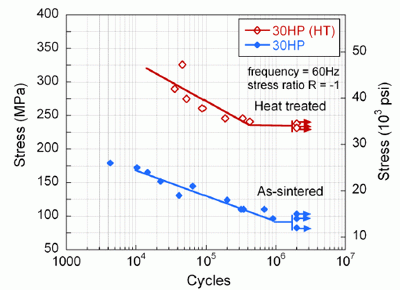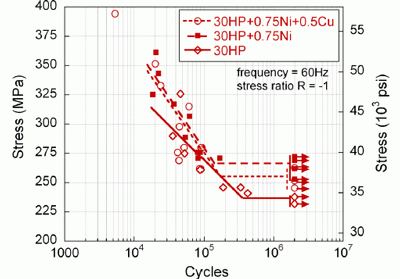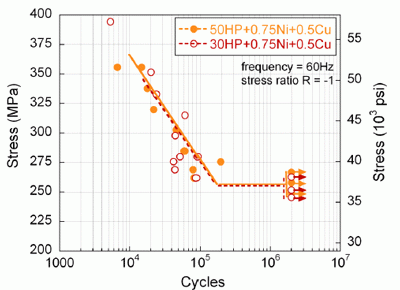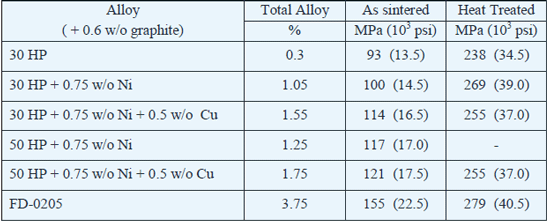Fatigue properties of high strength Powder Metallurgy structural part materials, Part 2
Peter K Sokolowski, Hoeganaes Corporations, USA and Roland T Warzel, North American Höganäs, presented the following papers during the session on Fatigue.
A further issue affecting the potential for the PM structural parts sector to target fatigue dominated applications is that the materials that have generally been proposed for such applications have tended to be relatively highly alloyed and hence relatively expensive. An ability to explore the potential viability of more recently developed, leaner alloying concepts in terms of achievable fatigue performance level is therefore also an important issue.
Two papers from major PM powder suppliers therefore sought to compare the fatigue properties of their own recently introduced, leaner-alloy high strength grades with those of the more traditionally specified diffusion alloyed grades, the same 4% Ni – 1.5% Cu – 0.5% Mo material studied in the paper by the German authors and/or a grade with the same levels of diffusion alloyed Cu and Mo but a lower Ni level of 1.75% (FD-05N2C, FD-0205).
Although these two papers focussed on lean-alloy grades employing different alloying concepts, they led to broadly similar conclusions regarding the potential viability of the grades for the replacement of the traditional diffusion alloyed grades in fatigue-dominated applications.
Fatigue performance of molybdenum prealloyed PM steels
The first of these papers came from P Sokolowski, B Lindsley and K McQuaig (Hoeganaes Corporation, USA) and focussed on hybrid PM materials based on fully pre-alloyed Mo grades, at the 0.3% or 0.5% level, with admixed additions of nickel and copper. The axial fatigue performances of these materials were compared with those of FD-05N2C/FD-0205 in both the as-sintered and heat treated conditions.

Fig. 3 As sintered axial S-N curves for (a) 30HP and (b) 50HP alloy combinations with 0.6% graphite. (As presented by P Sokolowski, Hoeganaes,USA, at PowderMet2011. Courtesy MPIF)

Fig. 4 Increase in axial fatigue endurance limit on heat treating
30HP + 0.6% graphite (As presented by P Sokolowski,
Hoeganaes,USA, at PowderMet2011. Courtesy MPIF)
Although work is still continuing to refine further the estimates of fatigue endurance limits, the results reported in this paper indicated that, in the as-sintered condition, the fatigue performance of the 0.3% Mo pre-alloy material (30HP) was improved with a 0.75% Ni addition and further enhanced with a 0.5% Cu addition (Fig. 3). Changing the base alloy from the 0.3% Mo level to 0.5% Mo (50HP) gave a further enhancement in endurance limit.

Fig. 5 Axial fatigue trends of heat treated 30HP alloy combinations
with 0.6% graphite (As presented by P Sokolowski, Hoeganaes,
USA, at PowderMet2011. Courtesy MPIF)
In the heat treated condition (oil quench from 900oC, temper at 205oC for 1 hour), the axial fatigue endurance limit of 30HP was boosted by as much as 152% compared with the as-sintered properties (Fig. 4). Admixing 0.75% Ni gave a further 13% increase in endurance limit, but an addition of 0.5% Cu was actually found to be detrimental to the heat treated endurance limit (Fig. 5). Initial work with heat treated material based on the 50HP grade has given indications that the additional 0.2% Mo had little or no effect on axial fatigue performance (Fig. 6)

Fig. 6 Axial fatigue strengths of 30HP and 50HP with 0.75%Ni, 0.5%Cu
and 0.6% graphite (As presented by P Sokolowski, Hoeganaes,USA,
at PowderMet2011. Courtesy MPIF)
The estimated fatigue limits from this study are summarised in Table 1. The overall conclusion was that, with less than one third of the total alloy content, heat treated 30HP + 0.75%Ni can provide a fatigue endurance limit that is within 4% of that of FD-05N2C/FD-0205.
It was proposed therefore that heat-treated 30HP with at least 0.75%Ni can provide a suitable fatigue performance to compete with more expensive alloys currently used, in parts with thin cross-sections. In larger parts, the additional hardenability provided by the 50HP grade may be required.

Table 1 Summary of estimated fatigue endurance limits (As presented by P Sokolowski, Hoeganaes,USA, at PowderMet2011. Courtesy MPIF)
Initial comparisons, based on estimates of axial endurance limits calculated from rotating bend data, suggest that the 30HP + 0.75% Ni material may match or even out-perform other popular grades such as FLN2-4405HT and F-05N2/FN-0205HT.
Dynamic properties of lean diffusion-alloyed steel
Finally, the paper from R Warzel III, B Hu, A Klekovkin and S Luk (North American Höganäs, USA) and R Frykholm and M Andersson (Höganäs AB, Sweden) adopted the diffusion alloying concept and compared the fatigue properties of a newly developed lean composition diffusion alloy, D.AQ, with FD-05N2C/FD-0205 and FD-05N4C/FD-0405.

Table 2 Plane bend fatigue endurance limits (As presented by R Warzel, North American Höganäs,USA, at PowderMet2011. Courtesy MPIF)
D-A.Q contains only 0.5% Ni and 0.5% Mo as diffusion alloying additions.
These comparisons were carried out exclusively in the heat-treated condition (oil quench from 920oC, tempered at 200oC for 1 hour) and comprised two types of fatigue testing – plane bend fatigue of ISO 3928 test bars at R = -1 and tooth root bend fatigue of HB gears at R = 0.1.

Fig. 7 SN curves for Mix 2 (D.AQ) (As presented by R Warzel, North American Höganäs,USA, at PowderMet2011. Courtesy MPIF)

Fig. 8 SN curves for FD-0205 (As presented by R Warzel, North American Höganäs,USA, at PowderMet2011. Courtesy MPIF)
The results of the plane bend fatigue testing are shown in Figs 7 and 8 and Table 2 (N.B. Mix 2 comprised D.AQ with 0.6% graphite and 0.6% lubricant; both the FD-0205 and FD-0405 mixes also contained 0.6% graphite and 0.6% lubricant) and indicate that D.AQ has an endurance limit at a similar level or possibly even slightly above the values measured for the FD-0205 and FD-0405 samples. There was a slight anomaly with the D.AQ results, however, in that the sample with the lower density level had the higher fatigue endurance limit. The reason for this anomaly is still under investigation.

Table 3 Gear Tooth Root Bending Fatigue Results (As presented by R Warzel, North American Höganäs,USA, at PowderMet2011. Courtesy MPIF)
The gear tooth bending results are given in Fig. 9 and Table 3. For these tests.D.AQ showed an endurance limit that was comparable to that of FD-0405 and quite close to that for FD-0205.

Fig. 9 Gear Tooth Bending Fatigue SN curves for the tested material systems (As presented by R Warzel, North American Höganäs,USA, at PowderMet2011. Courtesy MPIF)
Overall, therefore, this new material, with a much leaner composition, can be considered as a viable alternative to the more highly alloyed grades in fatigue-dominated applications.
< back to part one
Author: Dr David Whittaker is a consultant to the Powder Metallurgy and associated industries. Contact +44 1902 338498 email: [email protected]
News | Articles | Market reviews | Search directory | Subscribe to e-newsletter





